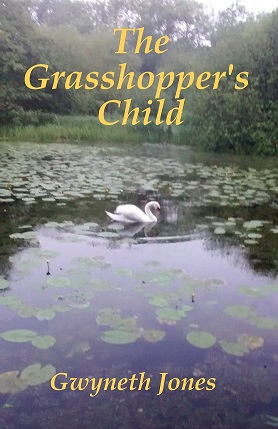Small, Ugly, Utopias

Small, Ugly Utopias: The Grasshopper’s Child, by Gwyneth Jones reviewed by Joel A.Nichols
Gwyneth’s Jones’s strange novel The Grasshopper’s Child is series of against-the-grain juxtapositions: a teenager of color from the city sent to care for two “Elderly Wrecks” whose great house and gardens are rotting around them, a near-future England so grim and violent that only the Chinese Empire’s invasion can stop the genocide and cannibalism, gardens that seem to teem with magic but instead let Jones show how internet-native teenagers can get down and dirty with Victorian plumbing technology. There are many more examples of points where the author has reached for the most disparate comparison in any given case and confidently pulled it into this novel in a realistic, ho-hum way. . . The overall effect is disjointed: is this an updated Nancy Drew, a satire of late technology (complete with holographic social workers and virtual popstar com-petitions), a refreshing teen friendship and love story that avoids romantic clichés in its desire to do the right thing by these teens, or something else altogether? There are many layers of mystery in this book, whether the reader is questioning the tragic murder that left Heidi’s father dead and her mother imprisoned; the shady conspiracies that infuse every part of life in this too-good-to-be-true rural idyll; or the much smaller scale but no less emotional mystery of what, exactly, the evil Crace is doing to Mrs. Scott-Ambrose, an elderly person being cared for by another teen.Indeed, Clancy, this other teen, is a shadowy question himself in the guise of a hooded rebel avoiding authorities and living rough, but possessing a tender heart . . . All you as a reader can trust is that Heidi’s gut will figure out (mostly) who is good and who is bad, what is safe and what isn’t. She isn’t the narrator. But if she were, I’d describe this book as having a reliable narrator and a completely unreliable plot in which fantasy-seeming reality . . . meets speculative social and political fiction of the grittiest order.
This near-future England on the mend from neo-Anglo-Saxon butchery and organized blood rites is fascinating, and so lightly drawn by Jones that details come only thread by thread, and still don’t add up to a very complete picture. The few details do leave the reader with unmistakable and terrible knowledge about how it must have been. Because Grasshopper’s Child is set in the world of Jones’s Bold as Love Cycle, simply sketching its outlines is sufficient for those familiar with that work. It’s effective for the rest of us, too: the light touch of her world-building pays off in massive impacts and is not to be ignored: “No-body had talked about it, it was never on the news, but everyone had known street kids were disappearing; and the homeless; anyone vulnerable, and anyone who tried to defend them.” Jones flicks a pebble down the hill in the first chapter, and by the end of the book, our very earth is shaking with the boulders crashing around us.
For the complete review see The Cascadia Subduction Zone (CSZ) back issues at: http://www.thecsz.com/past-issues/csz-v5-n2-2015.pdf

Comments
Display comments as Linear | Threaded